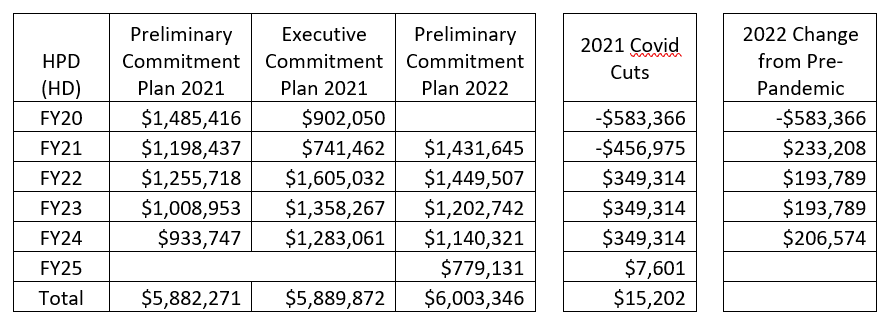Last week Mayor Bill de Blasio unveiled the preliminary version of his final budget. The $92.3 billion budget is almost $3 billion less than the current year’s budget and had to close a $5.25 billion gap, the impact of the coronavirus pandemic and the related recession. However, there is good news for housing production in New York City in the budget.
The preliminary plan increased the current FY 2021 HPD capital budget to $1.43 billion, $233 million more than the budget before the pandemic. The budget for FY 2022 is $1.45 billion, $193 million more than it was before the pandemic.
Last year, de Blasio cut $1 billion from HPD’s capital budget over two years. Last fall, he restored more than $450 million of that cut in the current year’s budget after New York Housing Conference showed that the cuts saved little money in the expense budget but cost the city thousands of units of housing.
However, the cut to last year’s budget – $583 million – went through. The additional funding in the current and next year’s budget restore roughly $425 million of last year’s cut. We estimate that these additional funds will allow HPD to produce an additional 7,300 units total over the two years.
We are encouraged to see this funding added back this year and next year. We have long argued that housing capital spending is an efficient way for the city to engage in stimulus spending, and the city desperately needs stimulus right now.

There were few changes in the expense budget for HPD. Given the city’s strained fiscal situation from the pandemic, HPD saw minor cuts in their budget as part of the city’s savings program. HPD is saving 945,000 this year and $1.6 million next year in the Department of Neighborhood Preservation and $500,000 this year for owner outreach, both by leveraging federal funding. They are also seeing $121,000 in savings this year in hiring and attrition for management. In good news, in the current year HPD was given $1.8 million for “new needs” including $350,000 for legal needs and $300,000 for temporary staff, both for development, as well as $700,000 for “ERP and AEP floodplain” and $461,000 for three-quarter housing programs needs.